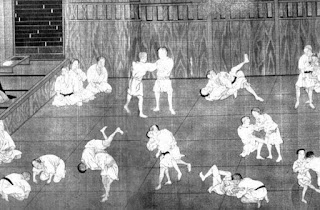Jujitsu is a 2500 year old unarmed combat discipline that has its roots in ancient Japan. The exact date on the creation of this martial art form is hard to trace but techniques resembling that of Jujitsu had already been incorporated into the training methods of the Samurai, from the 8th to the 6th centuries. Earliest Japanese historical records such as the Kojiki (Record of Ancient Matters) and the Nihon Shoki (Chronicles of Japan) also have passages related to unarmed combat systems.
Before this Japanese martial art developed into what we know as Jujitsu today, there were many other Japanese combat techniques such as Kogusoku, yawara, kumiuchi, and hakuda etc, also collectively known as Sengoku Jujutsu. Traditions finally gave rise to the modern Nihon Jujutsu we know today, which is classified under Edo Jujutsu – the true unarmed Japanese combat system.
Jujitsu gained prominence during the reign of Tokugawa in the 1600s but was soon alienated when Emperor Melse regained power. However, towards the mid-20th century, the ban on Jujitsu in Japan was lifted, following the Meiji restoration, and the combat art form began to be widely practiced.
The Philosophy:
Jujitsu revolves around three basic states of mind – Zanshin, Mushin and Fudoshin. The proper combination of these elements gave the power, preparation and potential to the practitioner to excel in the Jujitsu art.
1. Zanshin – “remaining spirit” – connotes the readiness for anything at any given time.
2. Mushin – “no mind” – Its spontaneity permits instantaneous action without conscious thought.
3. Fudoshin - "immovable mind" –during times of confrontation.
Basic Methods:
Jujitsu is a circular, hard and soft, external combat style. The basic techniques of attacks includes throws, locks, hitting and striking, thrusting and punching, pinning and immobilizing, strangling and joint-locking, with strong emphasis on throws, locks, and defensive techniques. In-fighting and close work are also focused upon.
Even though Jujitsu is basically an unarmed fighting system, small weapons like the Jitte (truncheon), Tanto (knife), or Kakushi Buki (hidden weapons), which include the Ryofundo Kusari (weighted chain) or the Bankokuchoki (a type of knuckle-duster) may also be used in combat.
Competition Systems:
Conventional Jujitsu can be dangerous, or maybe even fatal if its fundamental techniques were to be applied. So, in order to make the art a safer sport for the competitive arena, systems and rules have to be introduced. That is why most of the competition methods have incorporated “Half-contact”, which prohibits serious attempts to knock out an opponent.
1. The Fighting System: This is the most popular method, divided into three phases. The first is for striking only, the second for striking, grappling and throwing, and the third includes ground-fighting such as chokeholds.
2. The Practical System: According to this rule, two defenders are surrounded by four attackers from four corners. Highest points go to the best defender judged upon effectiveness, oversight and control of the situation.
3. The Duo System: In this system, contestants are randomly chosen and awarded points for effective defences. The attacks are divided into four groups of five attacks each.
4. Combat Jujitsu: The most recent system developed in the United States. Victory in the competition is based on submission. The combat round between the two opponents lasts for not more than two minutes.
Inscription à :
Publier les commentaires (Atom)
-
The Belt Colors Of Taekwondo The belts and their colors that are used with Taekwondo aren't just a random assortment of colors that...
-
The Basics Of Tae Kwon Do Tae Kwon Do is a modern martial art, well known all around the world for it’s lightning fast, often high, spe...
-
The 5 Animals Of Kung Fu Also known as the Kung Fu fist forms, the 5 animals of Kung Fu are known all across the world, and are some of...




Aucun commentaire:
Enregistrer un commentaire